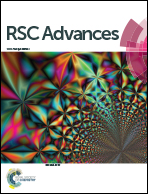Synthesis of a highly efficient phosphorus-containing flame retardant utilizing plant-derived diphenolic acids and its application in polylactic acid†
Abstract
Organophosphorus compounds as one of the most preferred flame retardants are traditionally derived from petroleum resources. Of recent interest is the exploration of renewable candidates as the precursors to synthesise these compounds. Here, we report the synthesis of a novel bio-based polyphosphonate (BPPT) through the reaction of plant-derived diphenolic acid (DPA), caged bicyclic phosphorus (PEPA) and phenylphosphonic dichloride (PPDC) in two steps. The BPPT was used as a flame retardant to prepare polylactic acid (PLA) blends. Significant enhancement in the limiting oxygen index of PLA (28.8, 33.7 and 35.4 with 2 wt%, 4 wt%, and 6 wt% of BPPT, respectively, in the PLA blends) was obtained. Additionally, the results in the UL94 flammability tests demonstrates that BPPT is effective to quench the flame, which facilitate PLA blends to achieve a V0 level at a BPPT loading of 4 wt%. The data of the cone tests and thermal gravimetric analysis confirm that a gas phase mechanism is mainly responsible for the highly efficient flame retardancy. Moreover, the tensile test results indicate that the BPPT-induced depression of the mechanical properties of the flame retardant blends is minimal. The flame retardant PLA blends developed herein contain a bio-mass content of more than 95 wt%.


 Please wait while we load your content...
Please wait while we load your content...